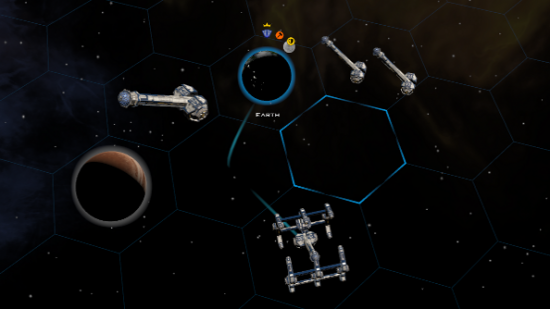Galactic Civilizations III, Stardock’s ginormous 4X flagship, has been in Early Access since March. Today it makes the move into beta. Starting up a game immediately evokes memories of its predecessor. At first, it looks, if not identical, at least so similar that it feels like coming back to Galactic Civilizations II. That’s not a bad thing, and it’s by design.
“I’m hoping people will play GalCiv 3 beta and they’ll get the same feeling as GalCiv 2 and then they can go ‘wow this is going to be even better when it’s done’,” lead designer Paul Boyer told me earlier this week.
But peeling back that familiar surface reveals a game that is very much new. So new it’s not yet finished, and there are still missing features – most coming in later beta phases – like diplomacy, but also new because Stardock have managed to make some significant changes to the formula. And it looks like it’s paying off.
In this brave new world of early access games and premium alphas and betas, the terminology has started to lose meaning. What do they say about the state of a game? You’ve got betas where the game’s finished and the stability or netcode is just being tested. Or there are alphas where the devs are calling the game feature complete.
For GalCiv 3, beta means that now you can have fun with it. It’s not finished, but there’s enough there so that you can spend hours playing around with it.
“We’ve always had these long early beta phases,” says Boyer. “Nowadays we worry about attaching the word beta to it, so what we did this time was we kept a lot of what, six years ago, we would have called beta in the alpha. And now the beta is still pretty early by today’s crazy standards, but the game is fun, all of the base engine is in, the base features are in.”
I spent a couple of hours with the beta prior to its launch, but that’s only enough time to scrape its surface. Boyer filled me in on the new beta features I might have missed. There’s the ideology tree, which I did get a chance to fiddle with. It’s like GalCiv 2’s own alignment system, but expanded considerably.

Making decisions, like whether or notto enslave an indigenous species or sacrifice your own people for a research bonus nets you points. These points can then be spent on the three ideology trees, where you can define your race as pragmatic fence-sitters, benevolent do-gooders or utter bastards. The trees offer a broad variety of things to unlock, from the instant gift of a new destroyer to empire-wide bonuses.
Race specific tech trees are in, as well. So your Drengin have all their horrible slave pits, if subjugation is your thing. And there are unique specialisations, too, allowing space emperors to unlock new research paths specific to their species.
Those floating things in space, those bloody asteroids that sit there, not doing anything, mocking you – they now have functions. Resources can be discovered and mined in them, though Boyer thinks he might not have given players much to do with the resources. But you can still build a constructor, send it over to the resource, and build a mining starbase. Immediately that makes the galaxy start to feel more alive, like there’s more to do than blasting away enemies with lasers and mass drivers.
And eventually, there will be even more options beyond turning aliens into space dust.
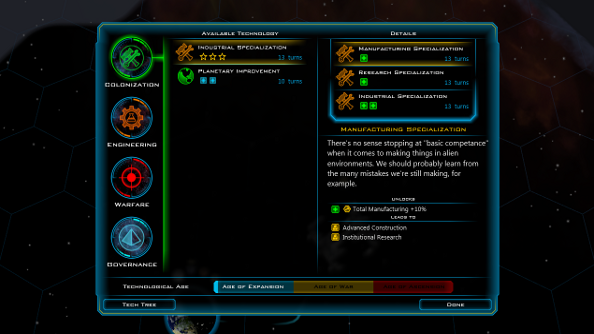
So far, GalCiv’s Early Access has only allowed players to wage galactic war. Conquest is the only obtainable victory, and from the moment the galaxy is created, everyone is at war. “Because so much of the game is based on the diplomacy and the building and the growing and trading, the fact that the alpha has been all about war has actually showing out worst side,” says Boyer. “We’re showing the late game mechanics in the early game, and that takes a lot of the fun out of the game.”
But the good news for beleaguered soldiers is that diplomacy is coming. Not straight away, though, it’s due in beta 2. It’s expanded for the third installment, giving encounters with alien races more personality and nuance. Different species will have different treaties. The Drengin, with their slave-based economy will have unique trade routes specific to the transport of people as goods and their own treaties based around that, for example.
Stardock wants to create more interaction between the player and their fellow galactic super powers, as well. “We’re going to try and have more interaction with the player. I know it’s kind of funny to say that because GalCiv 2 was known for its glib taunting of you. But we want more of that, but we would like to bring more of that into the diplomacy screen.”
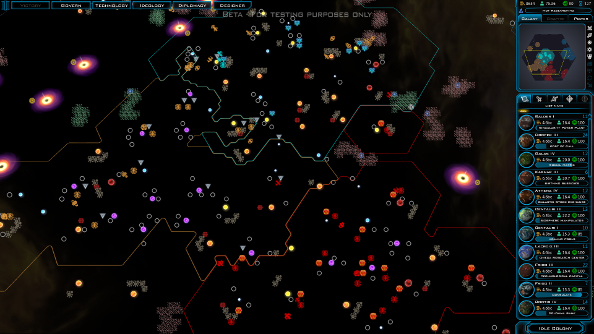
And with more races on the way, there will be more opportunities for that. During the various beta phases, more classic races will return. The Krynn, the religious zealots, will be coming with diplomacy, and the cybernetic Yor, the ancient Iconians and time-travelling Thalans will all be making an appearance soon.
Minor races, too, will find their way into the rebuilt galaxy. “Brad [Wardell] has this dream of having an enormous galaxy with 100 [AI] players in it, and that is our goal, we should be able to do it… it’s going to be pretty amazing,” says Boyer.
This time around, minor races will be built just like the major powers. Boyer hopes players will create their own custom minor races through the faction editor – just like they would a player race – or even have their own custom races that they’ve already played become a minor in another game.

They’ll have their general technology trees, as well as race specific stuff like the big boys. So the Dark Yor, a minor race with obvious similarities to the Yor, could share a lot of the Yor’s tech tree.
Now, I couldn’t chat about minor races without asking Boyer about the Snathi – the race of intelligent, psychopathic squirrels. He assures me that they will be returning, but as a fan of the species, Boyer also wants to give them a chance to shine.
“I do have this great idea for a DLC that will allow the Snathi to become a major, and I have all these crazy traits I want to give them,” he says. “Like I want to make it so that they’re essentially… I kind of think of them as evil Krikkit [from Hitchhiker’s Guide to the Galaxy], but with Squirrels. One of these days I want to have a whole campaign where a terran ship crashes on Snathi and they escape their world and they take over the whole galaxy. So that’s kind of my dream, to have this… I call it a mini-expansion, but it will be a DLC.”
Obviously that would be the best thing to happen to GalCiv. The Snathi deserve to have a galaxy to rule.

Being a space emperor also means being a ship builder. GalCiv 2 had an extremely robust ship designer that let players customise both the cosmetic design of their ship, as well as what modules and weapons it uses. This has returned for the third outing, and has been in the game in a limited fashion since alpha. So far all I’ve made is a fleet of phallic-shaped rockets – but with the complete editor, there are some truly amazing things that can be constructed. Boyer – who calls the designer his baby – made a vessel out of an asteroid, covered in drones that constantly orbit it. Every ship in the game is made using that tool. Boyer’s even considering expanding it so it covers starbases as well, but that’s something for an expansion.
While the physical design of a ship is cosmetic – Stardock did dabble with having directions of fire, but decided it would limit what people could design – the finished tool will be a lot meatier than its predecessor.
“What we’re doing instead is we’re making it so that there are more and more unique modules,” Boyer says. “And really, the big limiting factor, same as it was in GalCiv 2, is just mass. If you want a ship that can cut through shields, you can do that. You get the shield leech augment, you put that on there, but now it’s pretty big, and now the only thing it’s good for is beam weapons, so you’ve gotta put a bunch of beam weapons on there, and now it’s taken up a bunch of space, so it really can’t be fast.”
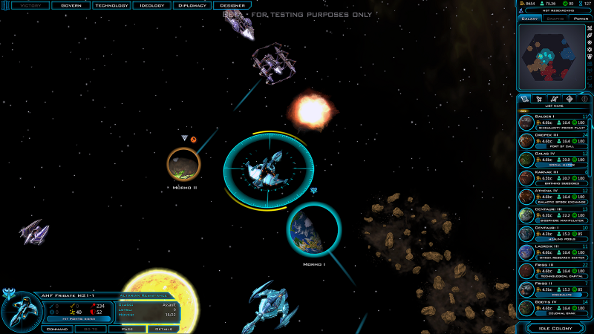
This is where thrusters come in. As well as a ship’s hyperspace engines, there are now sub-light thrusters which can ensure vessels get into battle faster. It won’t affect movement rates on the huge map of the galaxy, but it will make them quicker during when they duke it out in the hands-off battle viewer.
But right now, the designer is a bit “vanilla”, yet it hints at a much more impressive future. There are already some augments available that, when attached to ships, confer bonuses, any they are tasters for the game-changing support modules that will be appearing down the line. There will be as many support modules as regular ones, and they allow space emperors to further specialise vessels, should they wish to.
Boyer offers the example of installing a ship module on a vessel which would allow it to reduce the shields of all enemies in the vicinity, or boost the attack of the whole fleet. These support ships change the nature of fleets. Rather than being a case of winning through superior firepower, a thoughtful approach is being encouraged. Bringing the right ships into the fight will be more important than simply bringing the biggest, most gun-laden ships.
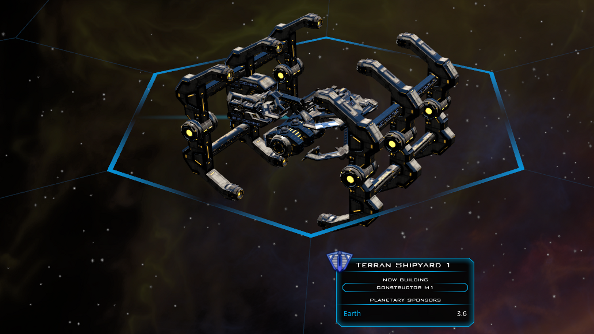
There’s also a blueprint system, which has been in the game since alpha. It’s a double-edged sword. It’s very convenient, in that it upgrades the ships available in the shipyard based on current technology. So if you’ve got some unshielded defenders, and then you research shields, a new version will appear which now employs that tech. But Boyer worries that it’s too good, encouraging players just to use blueprints rather than make their own. “We want you to be able to, but we really don’t want you to want to.”
All this ship building requires money, of course. GalCiv 3 has drastically changed how empires are managed. Instead of dozens of sliders, there’s now an allocation wheel – which can be fiddled with for the whole empire or a specific planet – that allows emperors to dictate the empire’s focus. More research? Hoard money? But player feedback inspired the introduction of a slider beneath the wheel – one specifically for balancing military and social spending. “It’s probably as intricate now as it was in GalCiv 2, but much easier to understand,” says Boyer.
The promise of a sandbox, where galaxies can be conquered, and the only narrative is the one that players create through their own actions, has always trumped the campaign in GalCiv. “Our bread and butter is the sandbox, the strength of the game is the sandbox,” Boyer tells me. But Stardock still want players to experience the campaign.
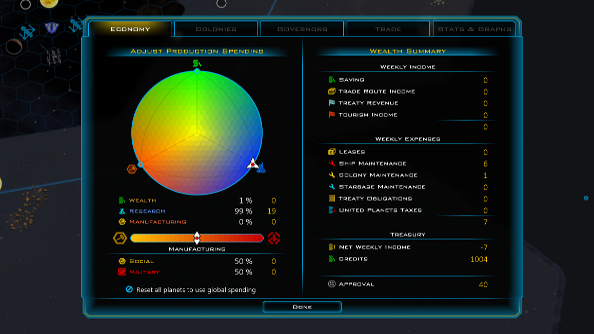
The humans have escaped the pocket universe, and they’re coming back to conquer the galaxy and retake Earth. Everyone else is less than enthused about the prospect. It’s going to be around the same size of the Dread Lords campaign, but rather than it seeming separate from the sandbox mode, Boyer hopes that it will feel like a string of sandboxes connected by a narrative. And things will carry over from one mission to the next, like technology – so there’s a sense of persistence.
At the very least, he hopes that players will go through the tutorial campaign, since there are a lot of changes being introduced, and even veterans might need a quick class in galactic domination before they delve into the sandbox.
Even though there’s still so much more to come, as it gets closer to launch and new beta phases are introduced, GalCiv 3 already feels like it’s heading in the right direction. Between ship building, spreading throughout the galaxy greedily swallowing up resources, and managing billions of people who will happily kick up a fuss if things don’t go their way (you can always through a planet-wide party to appease them, of course), there’s a lot to do other than fight – which was really all there was to do at the start of alpha.
Galactic Civilization III’s beta also sees the price drop. You can grab the Early Access game for £26.99/$44.99. You might want to wait until diplomacy gets implemented, but even now, the game’s really starting to become fun.
